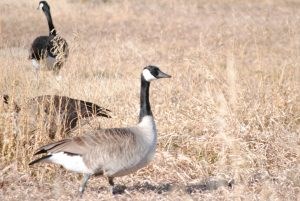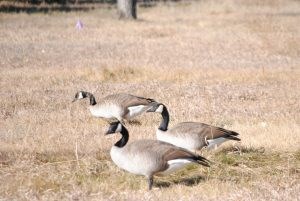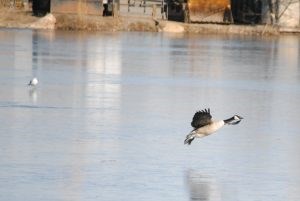This content was originally published by the Longmont Observer and is licensed under a Creative Commons license.
Christmas is nearly upon us so I thought I’d do an article on the Canada goose because some people like to cook goose for Christmas dinner. Nearly driven to extinction in the early 1900s, reintroduction programs were so successful that now Canada geese have become a nuisance in some areas. In some places, Canada geese have either become nonmigratory or do not migrate as far south as they once did to reach wintering grounds. This is largely due to a change in agricultural practices that has made food more available.

The Canada goose is a large bird with a long, black neck. They have white on their cheeks that extends under their chin, and they have a white undertail. The back is brownish-grey and the breast is tan. Canada geese have a wide, flat bill and large, webbed feet. They weigh between eight and thirteen pounds and are 22-40 inches long. Males are larger than the females.
You can find Canada geese near bodies of water, areas of grass and grain fields. Geese are particularly good at digesting grass. In addition, large grassy areas give geese an unobstructed view of predators that may be lurking, a particularly important feature when young are present. Because of this, geese are ubiquitous on golf courses and in parks. Geese also consume grain in empty fields and aquatic plants, insects, small crustaceans, berries and seeds. Canada geese forage on the ground or dabble in shallow water by extending their necks underwater and tipping themselves forward.
Pairs begin to form in early spring, sometimes as early as late February. In a process known as “assortive mating” geese will seek a mate that is similar in size to themselves. Breeding typically occurs in late March and early April. Pair bonds may be reinforced by “cheek flashing” where members of the pair make the white on their cheeks visible to mates by shaking their head. Canada geese are monogamous and mate for life unless a mate dies, in which case they will seek out a new mate. “Divorce” does happen between mates, but this is very rare. The pair stays together throughout the year.

Pairs will defend a territory they have chosen to nest in. The size of the territory depends on how many nest sites are available compared to the number of pairs present. Territorial displays include head pumping, hissing and honking. If the intruder does not retreat, a physical altercation may occur where the geese grab each other by the throat or breast and hit each other with their wings. Canada geese have very strong wings and injuries can result. As an aside, I knew a wildlife vet that got a black eye after being slapped in the face by a goose wing.
The female selects the nest site and builds the nest. Nests are usually on the ground unless there are nesting platforms over the water available for them. Slightly elevated sites or sites with little surrounding vegetation are preferred so that predators can easily be seen. The female will create a scrape in the ground and lay nearby vegetation in the scrape. Finally, the nest is lined with down the female plucks from her body. Nest sites may be reused each year.
Canada geese usually only have one clutch of eggs per year consisting of 2-8 eggs. The female incubates the eggs for 25-28 days while the male stands guard nearby. Goslings are covered in yellow down and their eyes are open when they hatch. They will leave the nest with the pair within one to two days of hatching. At this point they are capable of swimming and even diving. Sometimes so-called “gang broods” form where several pairs and their goslings come together and associate with each other. These broods can consist of up to 100 goslings with a few adults accompanying them. The young will remain with their parents for the first year typically and will not breed themselves until they are 2-4 years of age.
Toward the middle of summer, geese will undergo a complete molt. During this time, they are unable to fly which makes them particularly vulnerable to predation. Molting usually takes about a month to complete.

As the weather turns colder, geese begin to associate in larger flocks. Flocks typically consist of family groups. The same stopovers along the route and wintering areas are generally used year after year. As they migrate, they fly in the well-known V-formation. Experienced geese take turns leading the flock. The reason geese fly in a V-formation is because aerodynamically, it reduces the amount of effort required by each goose to fly by creating lift for the geese behind the lead goose. This allows them to migrate up to 1,400 miles per day!
You can find Canada geese throughout Longmont where there are large, open grassy areas or water. One of my favorite places to watch these birds is at Golden Ponds. You can hear them honking as they approach the ponds, followed by the sound of them flying. Looking up, you can see between 20-50 geese come in at a time and land on the pond. Early morning or late afternoon are good times to see them on the ponds as they are out in surrounding fields feeding during the day. Take some time to enjoy and admire these birds.


